Crate training is recommended by most trainers and breeders these days. It is believed that a crate will appeal to puppy’s natural “den animal” instincts. The purpose of crate training is to provide a secure, comfortable den or play area for your dog. The ultimate goal of it is to make the crate a positive retreat for your dog – a place where he will go willingly and autonomously for rest, safety, and comfort. In this article, we aim to guide you through how to crate train a puppy. We also provide a sample puppy crate training schedule for you to follow.
Benefits of a Crate Trained Dog
-
Benefit #1:
Security. The crate will be your dog’s personal retreat – a specific area that serves as a private den or resting area.
-
Benefit #2:
Safety. Crate training is similar to putting a young child in a playpen or crib for playtime or sleeping. We all know what trouble little kids can get into – and puppies are no different! If you don’t provide a safe confinement area for your puppy at times that you cannot directly supervise him, he will be able to wander around restricted areas and get into potentially dangerous situations. As such, crates are also highly beneficial for your dog’s safety.
-
Benefit #3:
Prevents damage. With a free-roaming puppy comes the likelihood of him engaging in destructive chewing, going potty in undesirable places, and other undesirable situations. You don’t need to worry about damage in your home with properly crate trained dogs.
-
Benefit #4:
Aids in chew training and potty training. Crates can be beneficial by aiding in the training of proper chewing and potty training by preventing failure and encouraging success.
-
Benefit #5:
Traveling ease. Crate training can accustom your dog to confinement for traveling and boarding.
-
Benefit #6:
Improved relationship with your dog. A crate trained dog causes fewer problems, and therefore less discipline for your dog and less frustration/anxiety for you.
Choosing the Ideal Crate
Part of how to crate train a puppy properly includes choosing an ideal crate. The ideal crate should be just big enough for your dog to stand up, turn around, and lie down in.
Now, we’ve done some research on dog crates. Metal wire dog crates can be dangerous and are not the advised crate-type by animal hospitals, especially if you have a strong and/or intelligent puppy (Lord knows Doodles are BOTH!).
Metal wire crates can severely injure puppies; sometimes paws are amputated, and they have apparently killed some puppies who have tried to squeeze through the wires. Collars can also get caught in between the wires, creating a very dangerous and fatal risk. Use at your own risk.
At the very least, wait until your dog is older and properly crate trained before getting him a wire crate. Nevertheless, you can find a highly-rated metal wire dog crate below.
In the meantime, a soft dog crate, or plastic one are safest. Even better if you can find a soft or plastic crate with a divider so you can enlarge the crate as your puppy grows. (If the crate is too large, it is possible that he may sleep on one side and use the other side as his potty.) A 25-inch long crate is plenty for a puppy, but later, you will probably have to upsize.
Some dogs adapt quicker to a small room, run, or doggy playpen. If you don’t want to use a crate, you may choose to contain your dog in a pen or puppy-proofed room that’s sealed off with a baby gate. These options will give your puppy more room and freedom to stretch out and play with his toys.
Whatever you choose for how to crate train a puppy, be sure that it is a secure, inescapable form of confinement. If your dog is confined when he is in need of play, attention, or to go potty, then he may try to escape the confinement area. And if he is ever successful at escaping, then more ambitious escape attempts will likely occur in the future.
Dog Travel Crate
Not meant to replace a full-size crate, a travel crate/carrier will be great for transporting your puppy and keeping him safe during car rides and road trips. Here is a highly-rated dog travel crate that will last your puppy’s entire lifetime:

Baby Gate, Dog Playpen, or Play Yard
If you want to have dynamic control over where your puppy can roam inside the house, baby gates are incredibly handy and easy to move. If you can, get something extra tall to prevent a hop-happy puppy from escaping. Here is a highly-rated baby gate product:
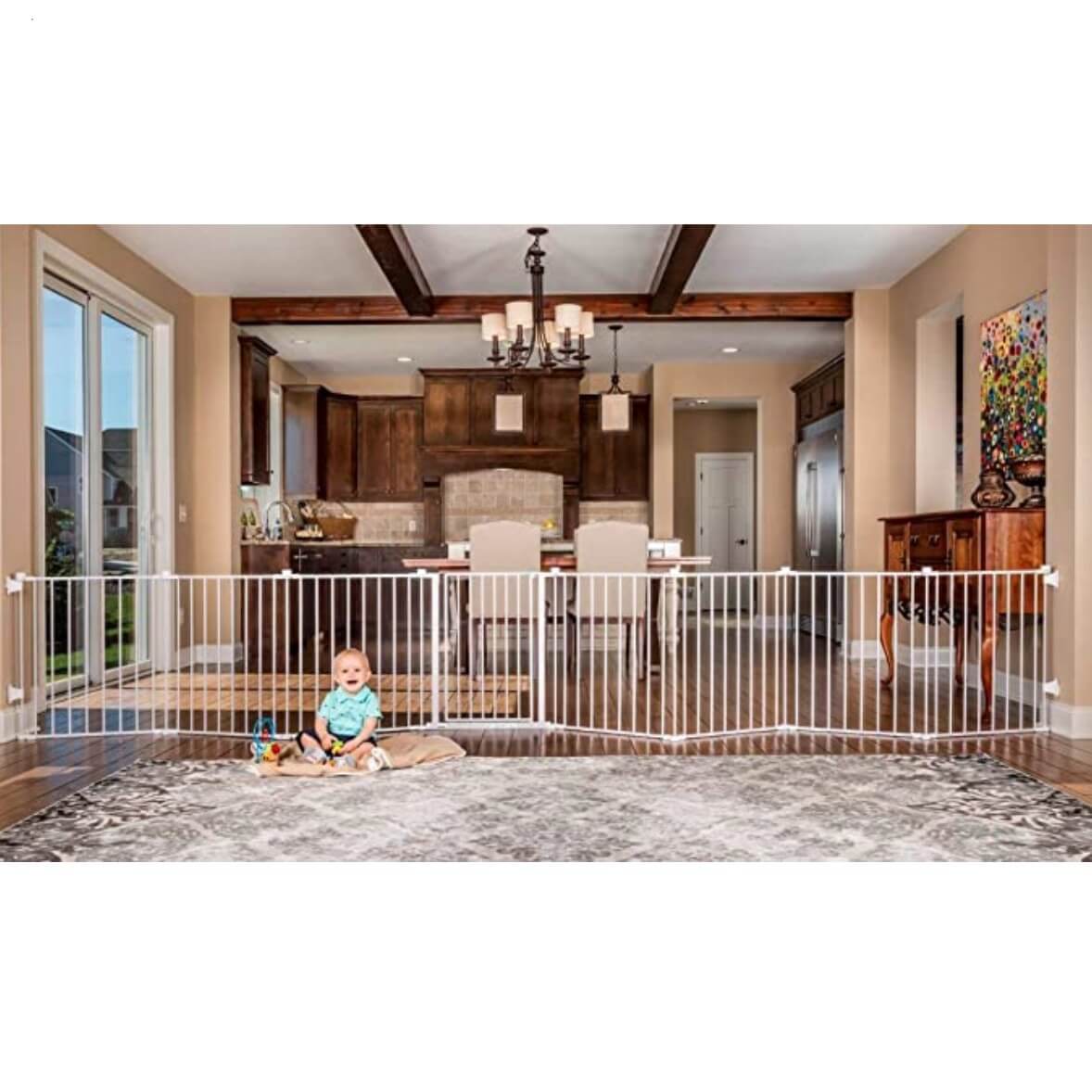
An alternative to using baby gates, a moveable playpen or play yard can give puppy a place to stretch out and play safely.
Be sure to supervise your puppy while he’s inside the playpen to avoid any accidents as mentioned in the Dog Crate section above.
How Long Does it Take to Crate Train a Puppy?
Crate training a puppy can take days or weeks, depending on his age, temperament, and past experiences and associations. As long as the crate is always associated with something pleasant, it should be fairly easy to reach the goal of making the crate a place where he will go willingly and autonomously for rest, safety, and comfort.
For Doodles of all kinds, crate training tends to be fairly easy based on feedback for trainability. However, Doodles are consistently rated across the board from poor to excellent when it comes to separation anxiety. Separation anxiety could definitely lengthen the amount of time to reach the goal of a properly crate trained dog, but it really depends on the individual dog’s temperament and tolerance.
How to Crate Train a Puppy
While the following methods are effective in how to crate train a puppy, perhaps you’d like to hear more about this subject directly from a professional trainer. Amy Jensen, founder of Baxter & Bella – The Online Puppy School, hosts a great podcast called The Puppy Training Podcast where she addresses lots of puppy training techniques. Here’s a great episode on crating.
Need help with training?

Use our discount code: DOODLEDOODS at checkout for an instant 25% off of BAXTER & BELLA, The Online Puppy School – an incredible value on their lifetime membership!
Learn More About BAXTER & BELLAWhere Should You Put a Dog Crate in the House?
Location of the crate will highly affect your efforts on how to crate train a puppy.
Because dogs are social animals, an ideal location for the crate is within an area that the family visits often. This could be in the kitchen, living room, or bedroom. If you have noticed that your dog likes a particular corner or room to take a nap, or if you want your puppy to sleep in a particular location at night, then this might be the best location for the crate.
Avoid putting the crate in an isolated area like the laundry or furnace room.
If you’re trying to decide whether to put the crate up- or downstairs, consider getting two crates – one for each level of the house. Some fellow Doodle owners have done this with great success:

Introducing the Crate, Step-by-Step Guide
Here is a short step-by-step guide on introducing the crate to your puppy.
- Ideally, you should have the crate ready to go the day you bring your puppy home.
- The best first confinement session should be when the puppy is ready to take a nap and as early in the day as possible. This will likely be after a playtime, exercise, and going potty.
- Place a few treats, toys, or food inside the crate so that your puppy is keen on going inside on his own. If he doesn’t seem to want to go in by himself, place him inside and close the door. If the puppy lies down elsewhere to take a nap, move him to his crate for the duration of the nap.
- Leave the room but remain close enough to hear your puppy. Some level of crying or whining is expected the first few times he is separated from his family members.
- Only release him from the crate when he wakes up, is calm, or if you need to wake your puppy up for feeding, play, or a potty break.
- Repeat these steps a few times before bedtime.
- Over a few weeks, gradually increase the amount of time that your puppy stays in the crate. Cap the max time to three or four hours until the puppy is older than five months of age.
- Prior to bedtime, your puppy should be exercised and secured in his crate for the night.
- Repeat these steps each day until he willingly and happily goes into his crate on his own.
Avoid letting him out of the crate when he cries or whines. Ignore him until the crying stops.
The location of the crate, as well as the techniques you use for crate training should be designed to keep the crate association positive. For example, your puppy should be encouraged to sleep, nap, or play with his toys in his little den.
On the other hand, be mindful that if your dog is confined at a time when he is in need of play, attention, or to go potty, then he may try to escape the crate and experience anxiety.
Likewise, never use the crate or confinement area as a punishment. This may make puppy feel trapped, anxious, and frustrated. If a “time-out” is needed, consider sending puppy into the laundry room or bathroom – not into his crate.
Do everything you can to keep the crate experience 100% positive so you can avoid a lifetime of crate-induced anxiety in your dog. This is the most important goal in how to crate train a puppy.
A radio or TV may help to calm your dog and may help to mask environmental noises that can trigger crying or barking.
How Long Can You Leave a Puppy in a Crate?
Here is a good rule of thumb. Only leave a puppy in his crate in hours equal to the age in months that he is.
Example: if your puppy is two months old, only leave him in the crate for up to two hours at a time.
However, puppies under five months old really shouldn’t stay in a crate for more than four hours at a time – except at night – for a few good reasons.
First, their bladders are small and they’re still learning how to control it.
Never leave your puppy in his crate for longer than he can control himself or he may be forced to go potty in his crate. If your pup must be left for longer than he can control elimination, a larger confinement area with puppy pee pads, or access to outside through a dog door, will be necessary.
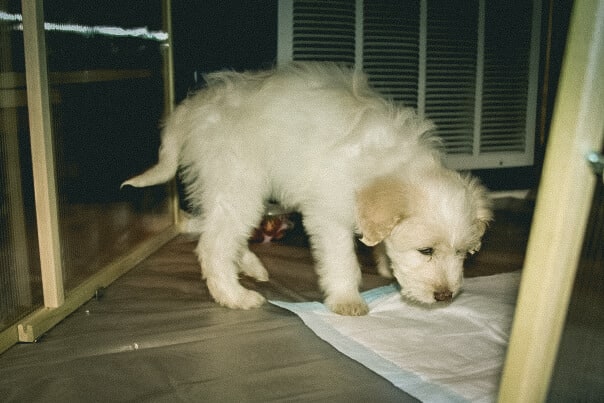
Second, puppies need a certain amount of socialization. This can really only be achieved when they’re free to roam and interact with their family members.
Crate Training Puppy – Crying and Whining
In your journey on how to crate train a puppy, you will 100% likely to experience a crying pup. Some level of crying or whining is expected the first few times he is separated from his family members while in his crate. For some unfortunate souls, your puppy may be rather relentless with the crying for much longer than that.
Either way, you are probably wondering “how do I get my puppy to stop crying in his crate?”
The issue of crying typically goes away on its own within the first week or two of consistent crate training. However, the crying might persist longer than that if certain actions are taken when he cries.
For example, avoid letting him out of the crate when he cries or whines and ignore him until the crying stops.
Moreover, only release him from the crate when he wakes up, is calm, or if you need to wake your puppy up for feeding, play, or a potty break.
If the crying does not subside on its own, you might find that a mild interruption helps. A mild interruption could be some kind of sharp noise, like shaking a can containing a few coins. A quick squirt from a water gun may also be effective.
During the interruption, you should remain out of sight, so that the puppy does not learn to associate the interruption with your presence.
Though not always viewed as a favorable option, another way to discourage crying or barking is to use a bark-collar or similar device that produces an alarm or distracting spray when he barks.
Avoid any interruption that causes fear or anxiety. These are not mentally healthy for your dog and could make the crying worse. They can even cause him to go potty inside the crate.
Should You Cover a Dog Crate With a Blanket?
Whether you cover the crate depends on your dog. Some dogs love the security provided by a darkened, enclosed space, while others can feel anxious in a confined area. A crate cover can help reduce anxiety and soothe dogs by limiting visual stimuli, which in turn can prevent excitement and barking. Easily excitable dogs are less likely to react to movement outside windows or in other areas of the building if they’re in a covered crate. A closed cover at night can signal bedtime, and an open one may indicate that it’s okay to play. (Source)
As with crate training, a gradual introduction to a cover on his crate is the best way to get him used to it. For steps on introducing your dog to a covered crate, check out this article.
How to Crate Train a Puppy at Night – First Night and Beyond
How do you crate train a puppy at night? Well, the same way you would crate train your puppy during the daytime! The only difference is that he and you will be sleeping (hopefully) and that he may be able to go longer periods without needing attention.
Is it Cruel to Crate a Dog at Night?
No, it is definitely not cruel to crate your dog at night! The crate still provides the same benefits (mentioned at the beginning of this article) during the nighttime.
Should I Let Puppy Cry in Crate at Night?
Some crying is to be expected the first few nights your puppy is in his new home. What do you do when your puppy cries at night? If your puppy cries in the middle of the night, you have some choices on what to do.
You can ignore him or use a mild interruption, as discussed above.
How to Comfort a Crying, Crated Puppy at Night
Alternatively, you can choose to comfort your puppy. When it’s too dark to see, he might not feel secure being all alone in his crate. You can comfort him by letting him know that you are present. You may also talk to him a bit if necessary, or put your hand on his crate. Another option is to sit or lay on the floor for a few minutes right when he goes into the crate if he is especially upset.
Also, new Doodle puppy owners are swearing by Snuggle Puppies left and right. The Snuggle Puppy helps puppies with its pulsing heartbeat and heat pack, simulating the comfort of mama. It is perfect while crate training, as it reduces whining and barking, and it helps puppies transition to their new home. The result is a calmer puppy who feels less loneliness, fear, and separation anxiety.
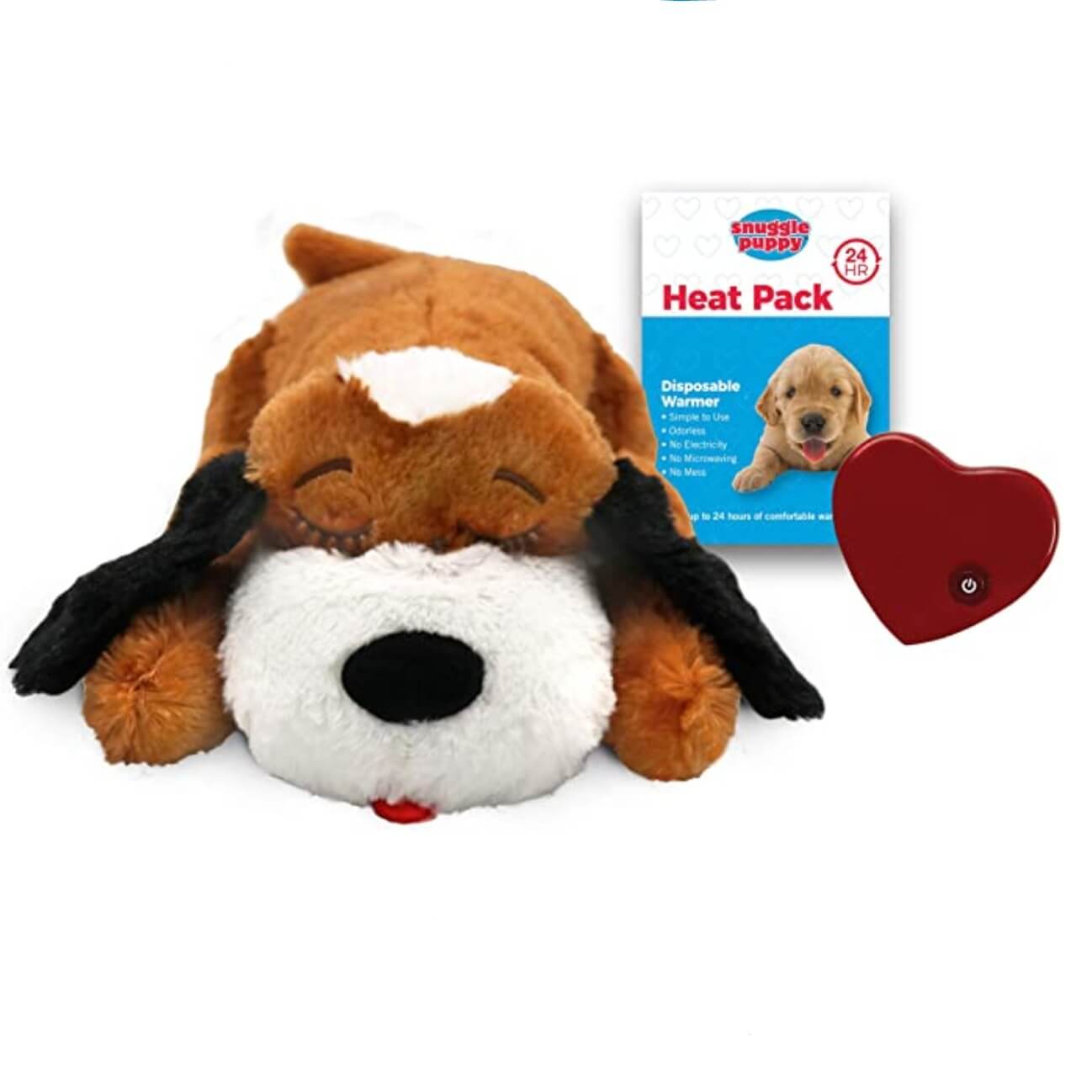
Find the Best Deal:
Where Should a Puppy Sleep the First Night?
You may be tempted to ease your puppy’s anxiety and comfort him the first night he’s home with you. As a result you might be wondering where should your puppy sleep the first night.
Should I Let My Puppy Sleep With Me?
Many older dogs are free to roam the house or sleep with their family members at night. However, when it comes to puppies, you should not let your puppy sleep with you if you’re keen on proper and speedy crate training. When your puppy is older and doesn’t seem to need the crate anymore, you can then reevaluate the sleeping situation.
Should I Sleep Next to My Puppy’s Crate?
You shouldn’t let your puppy outright sleep with you. However, oftentimes the best solution for crying and whining at night is to put his crate in your bedroom. If he can sense you nearby, he will feel more secure and at-ease…and hopefully will be less likely to cry and whine and keep everyone awake.
With the crate next to you in your room, you can comfort your puppy by your presence. You can talk to him a bit if necessary, or put a hand on the crate. Alternatively, sit or lay on the floor for a few minutes right when he goes into the crate.
Within a few nights, it’s likely that your puppy will be settling quickly and sleeping well (and so will you).
Crate Training a Puppy While at Work
Most of us need jobs to live. We get it. But if you have a full-time job, you can’t expect your puppy to be happy cooped up in a crate for 8 or more hours everyday. After a certain timeframe, it becomes cruel to do this.
Moreover, puppies can’t control their bladders for very long. The longest your puppy should be in his crate is 4 hours. So if you have a full-time job, you either need to take him out on your lunch break, or hire a dog walker or pet sitter who will let him out for a potty break everyday.
If your puppy will be home by himself all day, consider giving him a larger confinement area using a playpen or dog-proofed room. With more space, you will be able to put in his food, water, treats, and toys. You can also put in some puppy pee pads so he has room to play, eat, and go potty comfortably.
Puppy Crate Training Schedule
Here is a sample puppy crate training schedule you can follow. This schedule is appropriate for puppies aged 8-10 weeks.
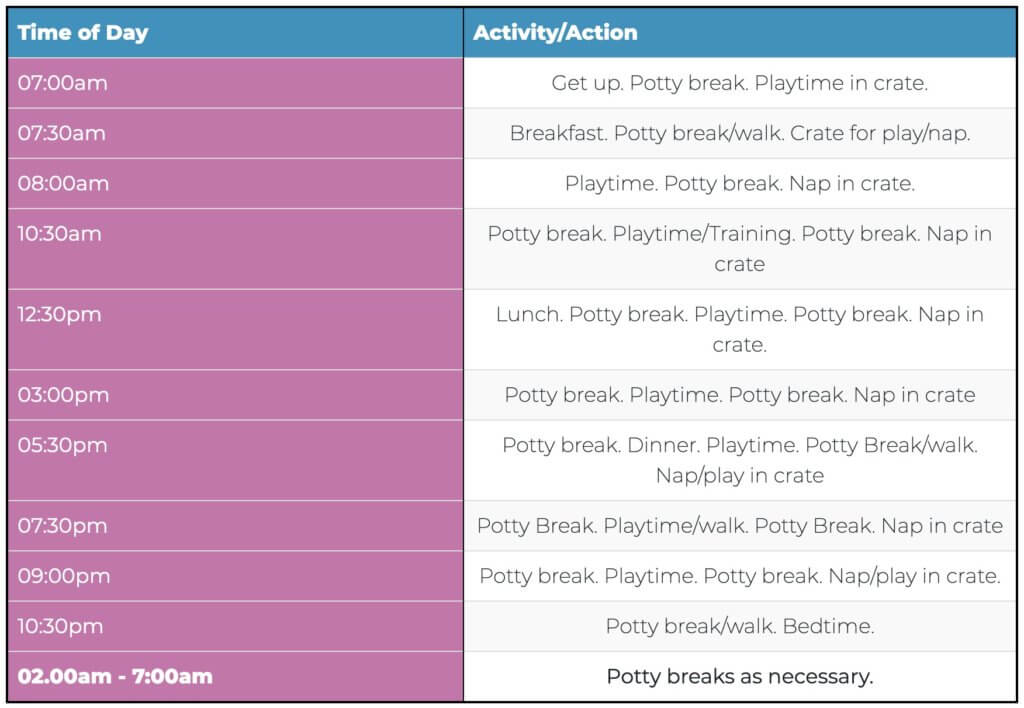
Transitioning Your Dog Out of the Crate
A new Doodle owner asks:

To which lots of fellow Doodle parents chimed in:


As you can see, age has little to do with it. Rather, it will vary based on a few things:
- Whether your puppy is fully house trained
- Whether he gets into trouble around the house or not
Crate Training Troubleshooting
If your puppy seems particularly anxious or goes potty in his crate, then it may indicate that some part of his crate training needs to be revisited.
If your puppy goes potty in his crate…
- It might be because he is being left in his crate longer than he can control elimination. Try crating your dog for a shorter amount of time. Make sure that he has gone potty before putting him in.
- It might be because the crate is overly large. Some dogs may sleep on one end and eliminate on the other. Consider getting a smaller crate or one with a divider.
If your dog is anxious or attempts to escape…
- It might be because he was not accustomed to his crate in a gradual and positive manner. Review the steps above to ensure that the crate is in a comfortable and secure location. Also ensure that each crate introduction is positive, and that the crate is not used for punishment.
- It might be because your dog has previously successfully escaped from his crate. This will encourage more escape attempts. Change it to be a more secure crate that is inescapable.
- It may be necessary to supervise your dog while he’s in his crate for a period of time in order to help reduce anxiety and deter further escape attempts.
When the Crate Just Isn’t Working
Some puppies and dogs just never take to the crate, and that’s okay! Some would argue that crates are unnatural for dogs anyway. Go with your gut, listen to your dog, and never force anything upon him. Chances are he will do just fine without a crate. Just ensure that you are training him properly in other ways to prevent damage and potty accidents in the house.
At Your Wit’s End? Get Professional Training
All this crate training talk got you overwhelmed? Or maybe you’ve tried everything and still can’t curb the crying or escape attempts?
We recommend BAXTER & BELLA, The Online Puppy School. The program includes more than 65 step-by-step lessons, over 100 how-to videos, unlimited LIVE! one-on-one professional help, canine coaching classes, training games, field trips and activities, printable charts and checklists, and so much more.
Need help with training?

Use our discount code: DOODLEDOODS at checkout for an instant 25% off of BAXTER & BELLA, The Online Puppy School – an incredible value on their lifetime membership!
Learn More About BAXTER & BELLALearn How to Care for Your Doodle Puppy!

Perfect for first-time Doodle parents, get ALL your questions answered, including questions new Doodle parents don’t even think to ask.
Plus, get $700 worth of Bonus Materials for FREE, including:- Doodle Parenthood Community and Support Group ($190 value)
- Doodle Puppy Growth Tracker ($20 value)
- EMERGENCY Cheatsheet: When To Call The Vet Immediately ($50 value)
- HELP! Button ($145 value)
- And SO MUCH MORE!

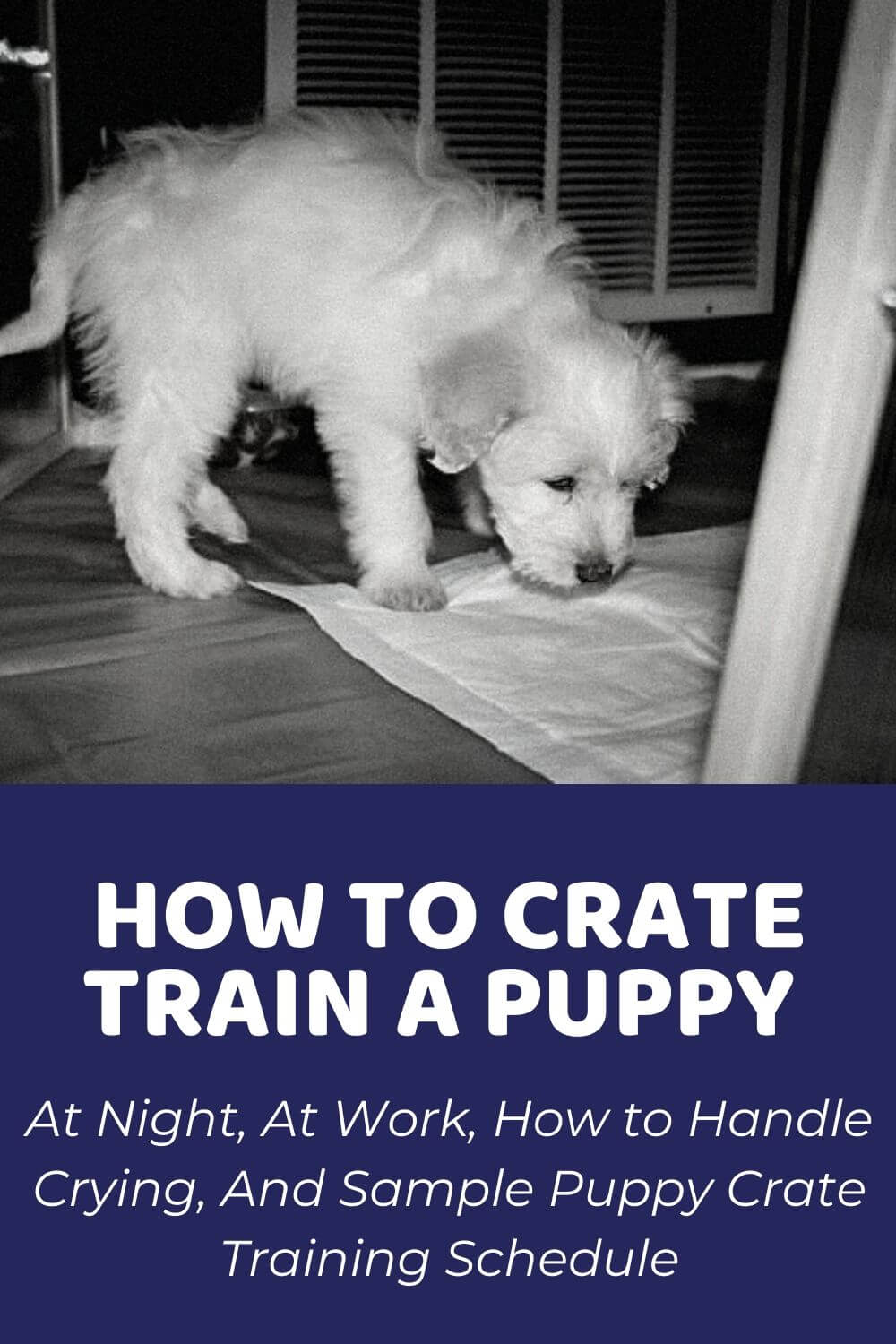

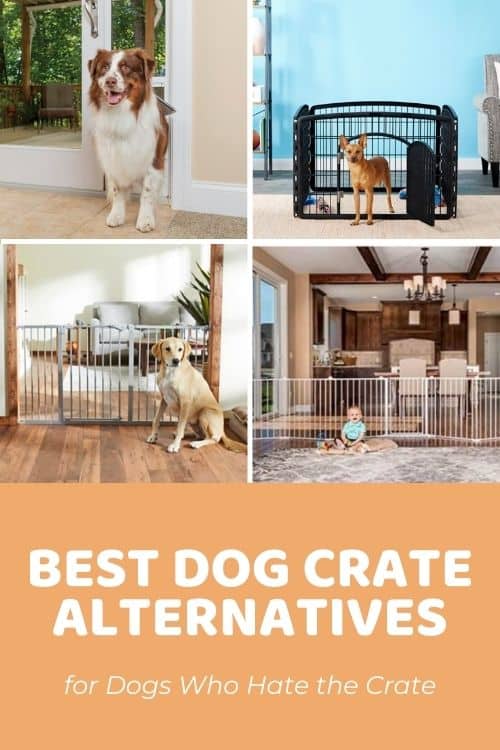
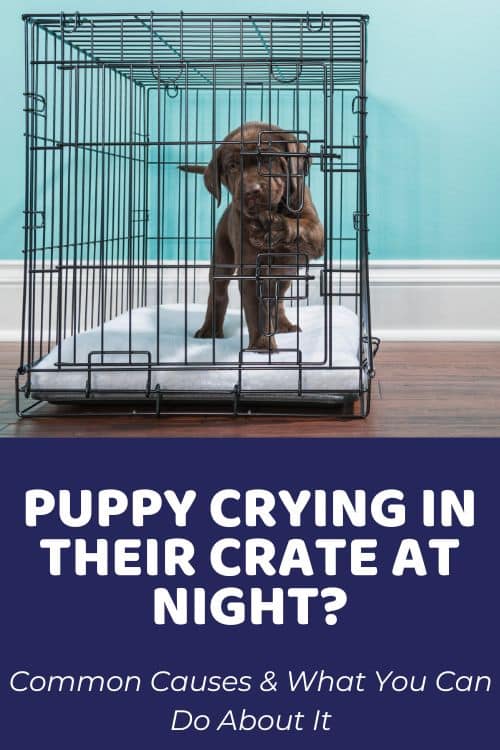
I have a cavapoo he’s 12weeks goes into his crate but won’t sleep in it, I have to fasten him in ,he wimpers -cries to get out and eventually will go to sleep but only for 15/30mins at most,please help I’m at wits end
March 31, 2023 at 7:51 am